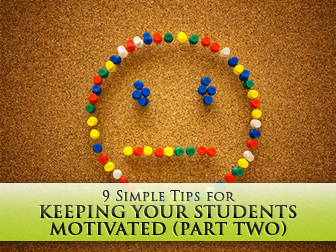9 Simple Tips for Keeping Your Students Motivated (Part Two)


This is the case for teachers anyway. Many students dread the thought of going back to the classroom after a fun-filled holiday break where they got to play with their friends, see relatives from afar and open new toys and games. As students file back into the classroom dragging their feet, your job as a teacher requires you to reignite inspiration in your students for another great semester.
Here are ten quick ways you can bring an inspirational attitude to your classroom and gear your students up for excellence in the New Year.

Visual cues serve as easy and consistent reminders for your students. When you splash important classroom information, such as the core principles of a classroom, goal charts and accomplishments and more on the wall, you make it easy for your students to remain aware of your expectations and stay on task toward accomplishing their goals. Hang visual reminders up in places that are easy to see at any time but are not a distraction to your teaching efforts.
Students thrive when they have a routine to follow in the classroom. With the New Year, you have a good reason to create a fresh new routine and get the input from your students about what they like and what they do not like. With their input you can get a good understanding of what motivates them and what will encourage them to do their best. Your new routine can include more group study time, more presentations instead of regular homework assignments, or a wider variety of tasks. Once the new routine is in place, hang up the schedule and stay regular so that your students always know what they can expect when they step foot in your classroom.
Simple furniture rearrangement can transform the vibe of your classroom. With desks in groups, you can encourage more teamwork. With a larger circle, you can create a larger sense of a unified team. When you want to inspire your students to act in a particular way, a physical movement of their desks and the furniture in your classroom can send a clear signal of your expectations and set them up for success.
Learning is more fun when there is something to work toward. While some schools limit the way teachers can reward students, there are easy ways to get creative with this approach. If your school is more flexible, you may be able to ask your students what they prefer. Give a few options, such as a movie day, field trip or game to play in the classroom. Even when they receive their reward, they will still be learning a lesson but they will feel as if they have won a prize.
Learning comes more naturally when a student enjoys what they are doing. Games are fun to play in the classroom and they offer students an educational experience without feeling as if they are being taught. By playing games on a regular basis, such as every Friday when students seem to be less than motivated to be at school, you can ingrain your lessons in an innovative and fun way giving your students a better shot at excellence.
A common complaint students have is that they are not sure why they are being taught what their teacher is lecturing about. When you make a lesson that seems obtuse more relevant to a student’s life, they are able to grasp onto the concept faster. This makes learning more fun and enjoyable for everyone involved. Make it a focus to find relevancy in each lesson plan to keep your classroom lively and learning.
Each of your students are at a different point in their academic career even if they are at the same grade level. Some students may struggle with math, while others struggle with writing. For many teachers, this makes creating group challenges difficult. Instead, allow your students to eliminate the peer pressure that may be holding them back by challenging each student individually to beat their own personal best.
As your class does well, keep the momentum up with positive words of encouragement. If your students are at an age where they are embarrassed by public praise, make an effort to praise them indirectly to another teacher where they can still hear you brag about their efforts or on paper where it is less likely to cause them peer embarrassment. When you are positive about their progress, they will be more likely to want to continue to make you happy with their efforts and will continue on the path that will bring them positive energy rather than negative results.
You are an authoritative figure in your classroom but your students may not always respond well to that. When you get real with your students, admit your mistakes and become more of a human in their eyes, they are more likely to respond to you. This can be a delicate balance so tread carefully. Still, finding a way to be human to your students can cause them to open up and respond better to your teachings.
Not every great idea will work for every classroom. The best thing you can do is to remain open to change and recognize when it may be necessary to switch direction in your teachings or lesson plans. Try something out for a minimum of two weeks to see how it works for your class. If something is failing, try another teaching approach. If something works, do more of it. This trial and error approach will help you to find the best way to inspire your students for excellence.
Use these tips to give your students a fresh start in 2013 and encourage them to do their best so that by the time the school year is over, you can watch your students achieve the excellence you know they are capable of!